The "Eye"
of God
in
The Church of
the Holy Sepulchre in Jerusalem

Photo by R. Malcolm Brown, Jr.
January, 1999
Scroll below to learn more about this photo and the amazing shots made
with a video camera during a recent trip to Israel.
As Background Material and an Introduction
Read below the words of Brother
Donald Mansir, F.S.C., K.H.S.
St. Mary's College, California, Former Vice-President, Pontifical Mission
for Palestine
"If there is one piece of man's
work on earth that should be
durable and perfect, a marvel of
gold and precious woods, it is the
vault on high, covering this most
sacred shrine."
These are the words written down by Harry Harewood Leech in his travel
journal entitled Letters of a Sentimental Idler, to describe his disappointment
with the shrine built over the site of Christ's death, burial and resurrection,
first by the Emperor Constantine in the fourth century and rebuilt
in the twelfth century by the Crusaders. In the 1860's, when Leech
wrote his account, the interior of the Church was shrouded in darkness:
the windows were boarded up and the Great Dome was filled with scaffolding.
After more than one hundred years of decay, the Great Dome was repaired
in the 1970's but the scaffolding remained. The three Custodians of this
shrine - the Greek Orthodox Patriarch, the Armenian Apostolic Patriarch,
and the Franciscan Custos of the Holy Land, as recognized by Ottoman law
- had yet to agree on the interior decoration of the Great Dome.
Thus, it remained veiled in darkness.
It was during lunch with the Armenian Apostolic Patriarch of Jerusalem,
His Beatitude Torkom Manoogian, that an American businessman, George Doty
of New York, asked if I knew an artist who might be able to come up with
a design for the interior of the Great Dome. He, George Doty, would finance
the project if the Custodians agreed. I immediately thought of Ara
"Corky" Normart. During my seven years as teacher and administrator
at San Joaquin Memorial High School, I had come to know him and his family.
Regularly invited to family celebrations, I came to know Corky as the not-so-brilliant
violinist whose real talents lay in the watercolors and stained glass.
While born into an Armenian family, his religious affiliation is Episcopalian.
I was sure the Custodians would presume, and rightly so that Corky would
not be prejudiced for or against the Catholics, the Armenians, or the Greeks.
His professional expertise in public relations
and advertising give him the skill to sell ideas and products.
This would be an important factor in developing a persuasive presentation
of a design to the Custodians. Corky is a pious man. We needed
an artist who would be willing to accommodate the many requirements of
the three Christian communities and whose ego would not get in the way
of the delicate work needed to maneuver through the history and international
laws governing all activity in the Holy Sepulchre.
I returned to New York and Corky to Fresno, California. A flurry
of faxes and courier mail traveled between the two cities as thoughts on
the design, which had to follow the directives established by each Custodian,
were exchanged. Some forty-two renderings were made. One had symbols of
the crown of thorns including the color red for the blood of Christ. Too
western and too Catholic. Another rendering had blue representing the heavens.
Too Greek. In the end, Corky was left with two colors: white
and
gold!
The finally approved design draws the pilgrim's eyes away from the tomb
and, as the angel declared, "Why do you seek the living among the dead?"
And so on August 17, 1994, Diodoris I, Greek Orthodox Patriarch of
Jerusalem, invited his brother Custodians, His Beatitude Torkom Manoogian,
Armenian Apostolic Patriarch of Jerusalem, and His Paternity, Reverend
Father Giuseppe Nazzaro, OFM, Custos of the Holy Land to the patriarchal
hall of the Greek Orthodox Patriarchate. An agreement had been reached!
The Agreement is the result of the pious creativity of Corky Normart. It
is the result of the good will and fraternal love among the current Custodians
who have acted collectively as one Christian leadership. This Agreement
is at its core a virtuous ecumenical act that has taken courage, trust,
and prayer on the part of these three Custodians and His Eminence Archbishop
Timothy of Lydda. As the Armenian Apostolic Patriarch of Jerusalem
declared, "This Agreement is a turning point for all Christendom!"
I am honored to have been associated with these Custodians, with Archbishop
Timothy and with Corky Normart. I am delighted that the Fresno Art Museum
saw the importance of the project and the talent of this artist, demonstrated
by an exhibit of the project and of his watercolors. It is truly satisfying
now to see the project and the artwork exhibited in NewYork, mounted by
the American Bible Society.
Brother Donald Mansir, F.S.C., K.H.S. St. Mary's College, California
Former Vice-President, Pontifical Mission for Palestine
I had never heard
of A.F. Normart, Jr. until May 20, 1999. I was watching a travel presentation
on Cable TV, and right before my eyes was a fantastic account of the person
who designed the dome decorations for the Church of the Holy Sepulchre!
Believe me, the
video effect that I captured in January was truly the work of God as I
had absolutely no idea was what was to transpire. As I aimed the
camera vertically from beneath the great dome and zoomed in, the 13 foot
diameter skylight details emerged with 14 silhouetted spokes. This caused
the exposure of the 12 gold radiating rays to become become obscure,
revealing an "iris" which gazed me directly in the face. Even more impressive
is the actual video which shows the subtle lighting transitions as I zoomed
out and the 12 gold rays become visible. These rays are to represent the
12 disciples of Jesus, and at the end of each ray are three points representing
the Holy Trinity. This event in January, 1999 during my visit did not seem
"totally random" to me. I felt that it is truly the "Eye of God" , the
site where Jesus ascended on the third day.
Below are some
of the images I captured that day. These are for anyone to download and
admire. They represent one of the most moving experiences of my life. What
are
your impressions as you begin to scroll through these images?
R. Malcolm Brown,
Jr.
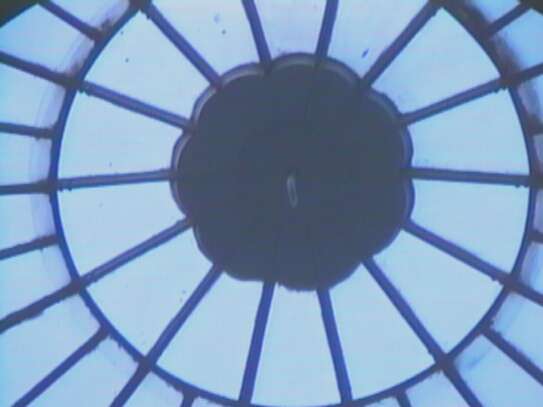
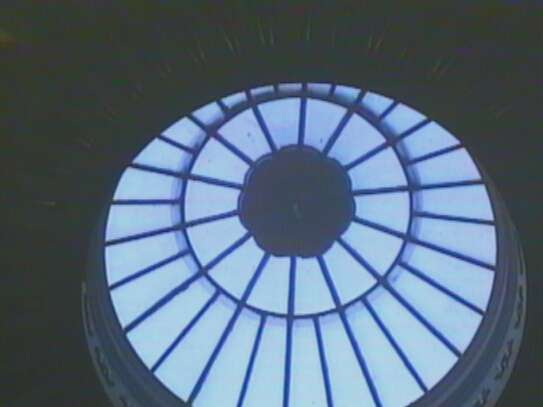
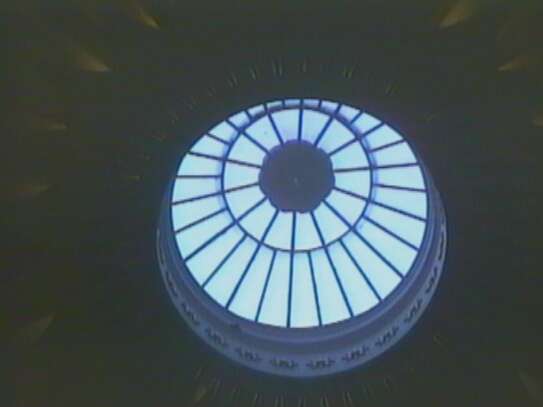
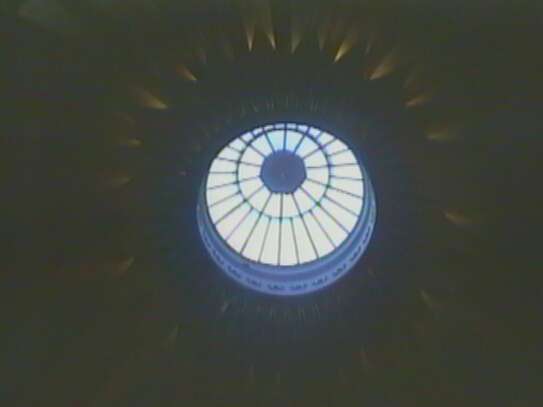
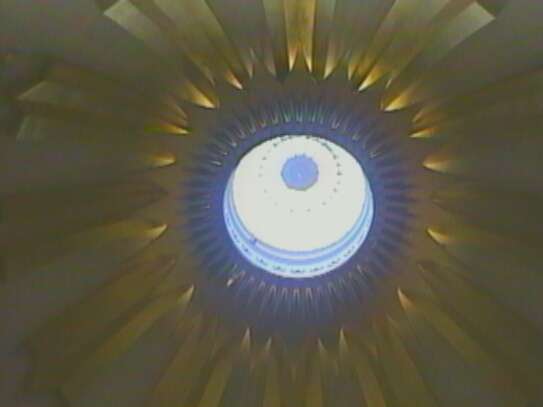
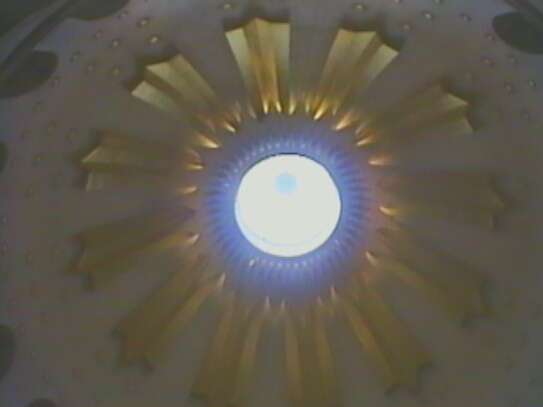
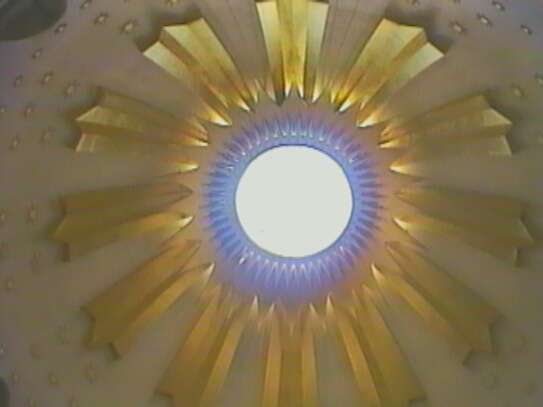
The Final Glory of the Image Below!
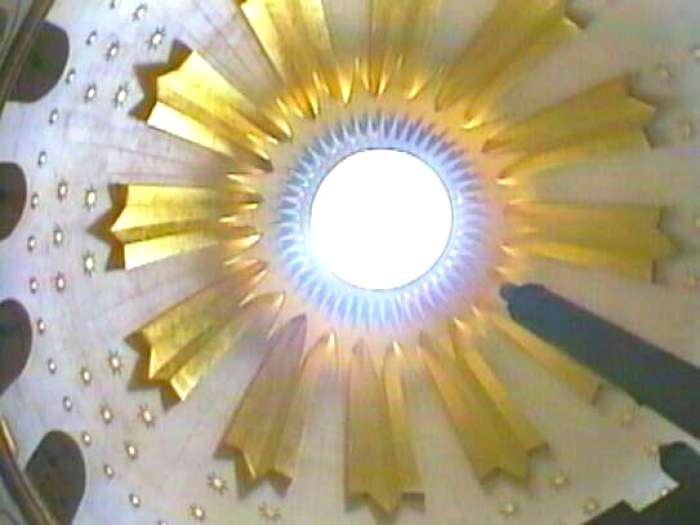
Here is more information on Mr. Ara "Corky" Normart,
Jr.
In the spring of 1994, a California
artist, A.F Normart, Jr., was asked to submit a design to finally complete
the reconstruction project that had lain dormant since 1980. In August
of that year, the custodians of Christendom's most holy sites unanimously
agreed to accept Normart's design. Work was completed in December of 1996
and a dedication was held on January 2, 1997 revealing a design of striking
simplicity that took advantage of the natural light entering the space
through a thirteen foot skylight at the very top of the structure. This
natural light is enhanced by artificial lighting that includes fibre optically
illuminated plastic rods, massive elements cast in relief and gilded in
23 karat gold and a 7250 square foot wall surface covered with a luminous
paint, again taking advantage of the unique lighting scheme.
Normart's design is symbolic
of the explosion of light at the resurrection, when, according to
Christian belief, "on the third day he rose again". The design consists
of twelve main rays, symbolizing the twelve apostles, each ray divided
in three representing the trinity. Centered and suspended below
the main rays is a ring of Golden Tongues of Flame, the flame that touched
the apostles at Pentecost. Mounted inside this ring is a circle of
white spears of light, each separated by two fibre optically illuminated
plastic rods, all signifying the explosion of light in keeping with the
theme of the decoration.
On the wall surface itself, three uneven
rays of light divide the space between the Main rays and a field of six
pointed "Jerusalem Stars" circles the base of the dome. Normart crafted
42 different versions of the design before settling on the thirty-eighth
version for completion. For the final presentation, a model was constructed
of plastic, complete with miniature lighting in place to demonstrate the
plane illumination of the dome interior. Normart, who is known primarily
as a watercolorist, is also involved in the design and production of dalle
de verre (faceted glass) windows for churches in Central California.
Here are some more very interesting links covering the restoration of
the dome of the Church of the Holy Sepulchre in Jerusalem. The unveiling
was January 2, 1997, my birthday!
Here
is an excellent site for the historical aspects of the restoration
of the dome. Click HERE
Another fine
webpage from Christusrex covering the Church of the Holy Sepulchre
Excellent
Inaugural and Construction photos
Inauguration
Ceremonies Link-Excellent!
Return to Photo of the ladder in the Church of the Holy Sepulchre-
Click HERE
Return to R. Malcolm Brown's Holyland trip Webpage-Click Here
Return to R. Malcolm Brown's Personal Homepage-Click Here
Questions? Send email HERE
Site constructed by R. Malcolm Brown, Jr. May 23, 1999








